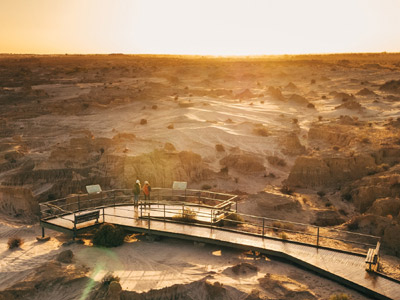
Out of this world … the Red Top lookout and boardwalk. PIC: Melissa Findley / NPWS
As grey nomads travel through remote Australia, they are constantly treated to an array of mind-bogglingly unique landscapes.
From the Pinnacles of Western Australia to the South Australian Painted Desert, there is surely nowhere else on Earth – or perhaps even on the Moon – quite like them.
But when it comes to the out-of-this-world vista award, the truly unforgettable Mungo National Park in the New South Wales west must surely take the biscuit. Located about 90 minutes’ drive north-east of Mildura, the terrain here is commonly described as Mars-like … but even that probably doesn’t do justice to the eeriness of the place.
Forming part of the greater Willandra Lakes World Heritage area, the park’s stunning centrepiece is Lake Mungo, which has actually not contained water for around 18,000 years!
The iconic Walls of China viewing platform is the place that every visitor simply has to get to in order to soak up the magnificence of the surroundings. It offers incredible views over the dramatic desert formations that have been sculpted over tens of thousands of years by wind and erosion.
The Red Top lookout and boardwalk is another unmissable spot to take in the views over the park’s deep ravines, rippling patterns and rich textures.
Full details of the park’s ancient history and information about the Mungo self-guided drive tour, also known as Mungo loop track, can be picked up at the Mungo Visitor Centre. The 70-kilometre loop crosses the ancient lake-bed to the Walls of China, taking in the iconic dunes and mallee country of outback NSW, before tracing the north-east shores of the lake.
The Mungo Visitor Centre has some great exhibits, and you can also organise taking various tours with an NPWS Aboriginal ranger here. Next door to the Visitor Centre is the heritage Mungo woolshed which was built in 1869 and at one time housed 18 hard-working men who would hand-shear more than 50,000 sheep.
This ancient place is, of course, of great significance to the Ngyiampaa, Mutthi Mutthi and Southern Paakantyi people … and home to the famous Mungo Lady and Mungo Man. The pair, found resting just metres apart, were buried more than 42,000 years ago on Lake Mungo’s shores … the planet’s oldest ritual burials. Along with 20,000-year-old fossil human footprints, they tell an incredible story of First Australians’ long history, and led to the establishment of Mungo National Park.
The park is also rich with wildlife and birdlife and is home to many emus and western red kangaroos, as well as birds of prey such as whistling kites, wedge-tailed eagles and brown goshawks.
For grey nomads seeking to camp in the park, the main campsite is just a short drive from the Visitor Centre and offers 33 sites and an amenities block; while the Belah Campground halfway along the Mungo Track is a bit more basic and offers 12 camping sites.
Whether visitors choose to camp at the main campsite or at Belah, or even if they come here on a day trip, this is one adventure – and one landscape – they are guaranteed never to forget!
